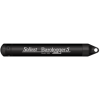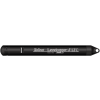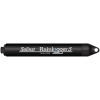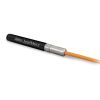Solinst Levelogger 5 Water Level Loggers
Features
- Single-eye optical interface - easier to clean, more scratch-resistant
- Increased memory: 150,000 sets of data
- Double o-ring seals for increased leakage protection
- Free ground shipping
- Expedited repair and warranty service
- Lifetime technical support
- More
Multiparameter Testing
The Solinst Levelogger 5 combines a pressure sensor, temperature detector, 10-year lithium battery, and datalogger, sealed within a 22mm x 160mm (7/8" x 6.3") stainless steel housing with a PFAS-Free corrosion-resistant coating baked-on using polymerization technology.
Hastelloy Pressure Sensor
The Levelogger 5 measures absolute pressure using a Hastelloy pressure sensor and offers high resolution and an accuracy of 0.05% FS. Readings are stable in extreme pressure and temperature conditions. The Hastelloy sensor can withstand 2 times over-pressure without permanent damage. Combined with the durable coating inside and out, the Levelogger 5 has high corrosion and abrasion resistance in harsh environments.
Protective Design
The logger uses a Faraday cage design, which protects against power surges or electrical spikes caused by lightning. Its durable maintenance-free design, high accuracy and stability, make the Levelogger 5 the most reliable instrument for long-term, continuous water level recording.
Level Sensor: Piezoresistive Silicon with Hastelloy Sensor
Accuracy: ± 0.05% FS (Barologger 5: ± 0.05 kPa)
Stability of Readings: Superior, low noise
Resolution: 0.002% FS to 0.0006% FS
Units of Measure: m, cm, ft., psi, kPa, bar, ºC. ºF (Barologger 5: psi, kPa, mbar, ºC, ºF)
Normalization: Automatic Temperature Compensation
Temp. Comp. Range: 0º to 50ºC (Barologger 5: -10 to +50ºC)
Temperature Sensor: Platinum Resistance Temperature Detector (RTD)
Temp. Sensor Accuracy: ± 0.05ºC
Temp. Sensor Resolution: 0.003°C
Battery Life: 10 Years – based on 1 reading/minute
Clock Accuracy (typical): ± 1 minute/year (-20ºC to 80ºC)
Operating Temperature: -20ºC to 80ºC
Maximum # Readings: 150,000 sets of readings
Memory Mode: Slate and Continuous
Communication: Optical high-speed: USB, SDI-12 57,600 bps with USB
Size: 22 mm x 160 mm (7/8" x 6.3")
Weight: 146 grams (5.2 oz)
Corrosion Resistance: Baked-on coating using polymerization technology (inside and out)
Other Wetted Materials: Delrin®, Viton®, 316L stainless steel, Hastelloy, PFAS-free PTFE coating
Sampling Modes: Linear, Event & User-Selectable with Repeat Mode, Future Start, Future Stop, Real-Time View
Measurement Rates: 1/8 sec to 99 hrs
Barometric Compensation: Software Wizard and one Barologger 5 in local area (approx. 30 km/20 miles radius)
In The News
2025 Essential Water Monitoring Gear
Stay ahead of the curve with five of the top water monitoring products for 2025. Technological advancements and manufacturing innovations are leading to better quality data, improved price points, and enhanced user experience. And, while the ‘essentials’ list includes several new products, two tried-and-true measurement instruments continue to take a top spot for portable instrumentation. These five products were developed by industry-leading suppliers, and in addition to extensive manufacturer testing, our science team tested and verified each instrument’s performance at the Fondriest Center for Environmental Studies .
Read MoreFrom Paddles to Phytoplankton: Studying Vermont’s Wildest Lakes
For six months of the year, Rachel Cray, a third-year PhD student at the Vermont Limnology Laboratory at the University of Vermont, lives between a microscope and her laptop, running data. For the other six months, she is hiking and canoeing four of Vermont’s lakes, collecting bi-weekly water samples. Cray studies algal phenology across four lakes in Vermont, US, that have low anthropogenic stress—or in other words, are very remote. Funded by the National Science Foundation Career Award to Dr. Mindy Morales, the lakes Cray researches part of the Vermont Sentinel Lakes Program, which studies 13 lakes in the area and, in turn, feeds into the Regional Monitoring Network, which operates in the Northeast and Midwest US.
Read MoreReimagining Water Filtration: How Monitoring and Science Enhance FloWater Filtration Systems
Over 50% of Americans think their tap water is unsafe , according to the Environmental Working Group (EWG). Other recent surveys have found that number to be as high as 70% of persons surveyed. Whether due to increased public awareness of water quality issues or confusion about how municipal water sources are regulated, there is a clear distrust of tap water in the United States. According to industry expert Rich Razgaitis, CEO and co-founder of the water purification company FloWater, this issue creates a damaging cycle. Razgaitis explained that the health and environmental problems associated with contaminated water aren’t the only issues. As people become increasingly aware that some tap water is unsafe, they resort to bottled water.
Read More



























































